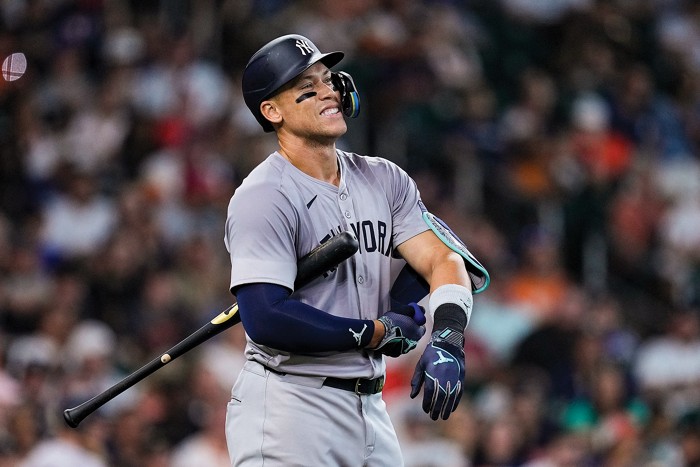
Credit: Associated Press
New Major League Baseball uniforms made by Nike and Fanatics are irritating players and fans because they feature sweat stains, as seen here on Aaron Judge of the New York Yankees during the game against the Houston Astros on 31 March.
Shortly after the 2024 Major League Baseball (MLB) season began in March, sweat stains began to bloom along with spring flowers. Especially, the sweat seemed to penetrate the gray uniform jersey team members wear when playing away, making them visibly dark.
It should come as no surprise to anyone, especially sportswear manufacturers, that athletes sweat. And synthetic sports performance fabrics, whether for soccer, track and field, tennis or low-impact activities, are designed to provide temperature control and antibacterial properties to help those who wear them. keep them comfortable and cool.
Actually 6 years of engineering entered the Nike Vapor Premier baseball uniforms, designed by Nike and manufactured by Fanatics, based in Easton, Pennsylvania, according to MLB. So what went wrong?
C&EN asked textile researchers to speculate, and they had fun doing it. “Textile structures are incredibly complex, and when you add chemical finishes, the degree of complexity multiplies,” explains Juan Hinestroza, professor of fiber science and apparel design at Cornell University. So the answer to what could have gone wrong is “all of the above,” he says.
The new MLB uniforms are designed to be more durable than the previous ones while improving moisture management and mobility. MLB and Nike say the uniforms are made from at least 90% recycled polyester yarn, feature Nike’s proprietary moisture-wicking Dri-Fit technology and are designed to provide 25% stretch in addition.
Performance fabrics wick away moisture using two methods, says Hinestroza. The physical method combines fibers of different diameters and shapes to create channels that wick away perspiration away from the body by capillary effect. The chemical route consists of coatings combining hydrophilic and hydrophobic materials to wick sweat away from the skin. Hinestroza says that, from what he sees in photos, MLB uniforms appear to have a reverse wicking function: “capturing moisture and returning it to the body.”
This could be due to recycled content, he says. Recycled fabrics may contain weakened raw materials from many sources and are often coated or blended with other materials to restore their original strength. Nike also adds a stretchy polyurethane fiber, called spandex or elastane, to the yarn. All of this results in a chemically and physically heterogeneous material that can behave in unexpected ways after the addition of coatings.
He says it’s also possible that there is an error in the formulation of a chemical fabric finish or that sweat interacts in unexpected ways with the finishes or structure of the textile.
According to Tasha Lewis, professor of fiber science and apparel design at Ohio State University, professor of fiber science and apparel design at Ohio State University, the problem could be that the material wicks moisture to the surface but so that the moisture does not evaporate. “Maybe something was done to the fibers or yarn to prevent” evaporation, she said. But Lewis doesn’t think recycled content should be a problem because companies have figured out how to properly recycle polyester.
Regardless of the underlying chemical or material fault, the problem most likely stems from the complex uniform manufacturing line. Every MLB jersey and pant is the product of multiple fiber and yarn producers, textile mills and chemical suppliers located across the globe. HAS Henri Boyter, textiles and finishes expert and director of the Center for Environmentally Sustainable Textile and Apparel Businesses, this is likely a quality control issue. “A lot of testing should have been done to ensure quality and that probably wasn’t done,” he says. “We only know for sure that human clothing testing was not completed or ignored.”
Hinestroza says researchers in his lab could help solve the problem if they could get their hands on samples of MLB uniforms. “This is a fascinating learning opportunity for people studying surface chemistry, textile chemistry and fiber science,” he says.
Getting samples to test might be wishful thinking. Nike did not respond to a request for comment. But the company said in a statement sent to The Athletic that he has “isolated the problem and (is) exploring a solution to minimize it.”
Lewis wishes Nike good luck. “I hope they solve this conundrum so people can focus on the game.”
Chemistry and Engineering News
ISSN0009-2347
Copyright © 2024 American Chemical Society
